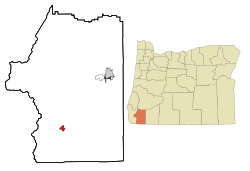Cave Junction, Oregon
| Cave Junction, Oregon | |
|---|---|
| City | |

Driving into town from the north
|
|
| Motto: Gateway to the Oregon Caves | |
 Location in Oregon |
|
| Coordinates: 42°10′0″N 123°38′49″W / 42.16667°N 123.64694°WCoordinates: 42°10′0″N 123°38′49″W / 42.16667°N 123.64694°W | |
| Country | United States |
| State | Oregon |
| County | Josephine |
| Incorporated | 1948 |
| Government | |
| • Mayor | Carl Jacobson |
| Area | |
| • Total | 1.82 sq mi (4.71 km2) |
| • Land | 1.81 sq mi (4.69 km2) |
| • Water | 0.01 sq mi (0.03 km2) |
| Elevation | 1,575 ft (480 m) |
| Population (2010) | |
| • Total | 1,883 |
| • Estimate (2012) | 1,875 |
| • Density | 1,040.3/sq mi (401.7/km2) |
| Time zone | Pacific (UTC-8) |
| • Summer (DST) | Pacific (UTC-7) |
| ZIP codes | 97523, 97531 |
| Area code(s) | 458 and 541 |
| FIPS code | 41-11850 |
| GNIS feature ID | 1139474 |
| Website | www.cavejunctionoregon.us |
Cave Junction, incorporated in 1948, is a city in Josephine County, Oregon, United States. As of the 2010 census, the city population was 1,883. Its motto is the "Gateway to the Oregon Caves", and the city got its name by virtue of its location at the junction of Redwood Highway (U.S. Route 199) and Caves Highway (Oregon Route 46). Cave Junction is located in the Illinois Valley, where, starting in the 1850s, the non-native economy depended on gold mining. After World War II, timber became the main source of income for residents. As timber income has since declined, Cave Junction is attempting to compensate with tourism and as a haven for retirees. Tourists visit the Oregon Caves National Monument and Preserve, which includes the Oregon Caves Chateau, as well as the Out'n'About treehouse resort and the Great Cats World Park zoo.
For thousands of years, the Takelma Indians inhabited the Illinois Valley. Their culture was destroyed when gold was discovered in the early 1850s, causing the subsequent Rogue River Wars. After an 1853 treaty, most of the Takelmas lived on the Table Rock Reservation. In 1856, after the wars ended, they were moved to the Grand Ronde Reservation and the Siletz Reservation.
The first gold in Oregon history was found in the Illinois Valley, as well as the largest gold nugget (17 lb or 7.7 kg). In 1904, more than 50 years after prospectors had started combing the valley for gold, an 18-year-old named Ray Briggs discovered what newspapers at the time called "the most wonderful gold discovery ever reported in Oregon history." While hunting along Sucker Creek, he discovered gold lying on the ground. He staked a claim and called it the "Wounded Buck Mine," which produced 1,777 ounces (50.4 kg) of gold. The "mine" was a small vein of gold 12 to 14 inches (30 to 36 cm) wide, 12 feet (3.7 m) long and 7 feet (2.1 m) deep.
...
Wikipedia
